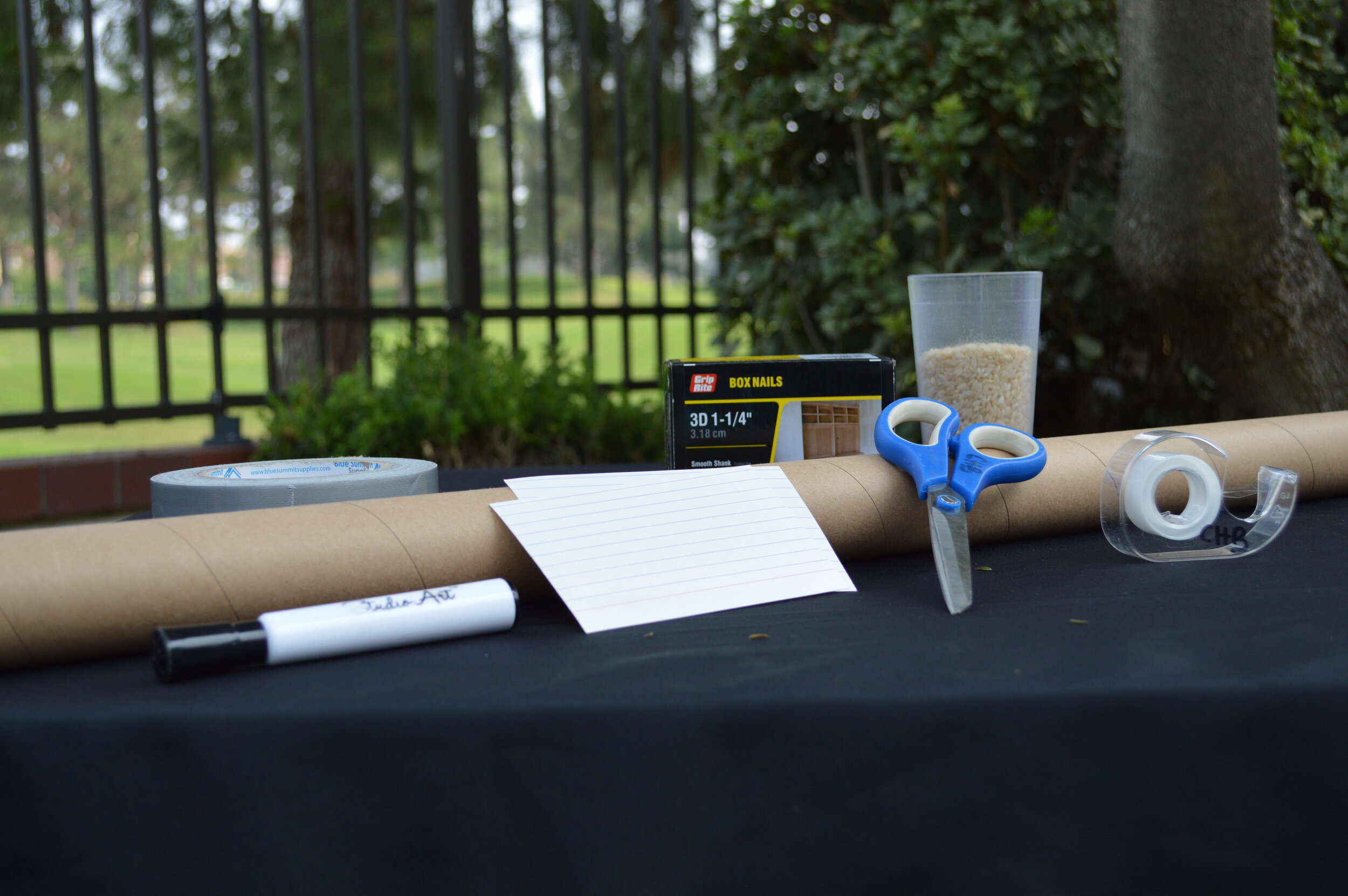Make Your Own Rainstick
Learn about the cycles of water and weather all while creating a fun and musical craft! A rainstick can easily be made from items around the house, and when it's done, it's a whole lot of fun!
Standards included in this lesson: NGSS K-ESS2-1, NGSS K-ESS3-1, NGSS 2-LS2-1, NGSS 2-PS1-1, NGSS 3-PS2-2. NGSS 4-PS4-1, NGSS 5-LS2-1, NGSS 5-ESS2-1, NGSS 5-ESS2-2, CCSS.MATH.K.MD.A.1, CCSS.MATH.K.G.A.3, CCSS.MATH.K.G.A.2
Materials
A long cardboard tube (Wrapping paper tubes work well but two paper towel rolls can also be taped together)
Marker
About 40 - 1 inch nails
Masking or packing tape
Two 3 x 5 index cards
Scissors
A few handfuls of raw rice or small dry beans
Procedure
Step 1
If using paper towel rolls, tape them together to make one long cardboard tube.
Step 2
The tube should have a spiral seam running down it. Use a marker to mark dots down the spiral about half an inch apart.
Step 3
Poke nails into each dot, going all the way through but not piercing the other end of the tube.
Step 4
Tape around the tube and over the nails in order to hold the nails in place.
Step 5
From the index cards, cut two circles that are large enough to cover the ends of the tube.
Step 6
Tape one circle over one end of the tube, making sure to create a seal.
Step 7
Take a handful of rice or beans and add it to the inside of the tube. You can cover the end with your hand and test it to see if you need to add more or less.
Step 8
Once done, tape the other circle to the other end of the tube and create a seal. Now you have a rainstick!
Science Explanation
Kindergarten - 2nd Grade . . .
- Weather is a combination of things like temperature (how hot or cold it is), how windy it is, how cloudy the sky is, and more.
- What type of weather is this experiment trying to replicate the sound of? (Answer: Rain)
- Rain plays an important role in the survival of living plants and animals.
- For example, you may know that you have to water a plant or else it will die. In nature, rain provides the water that plants need to grow.
- Rain is an example of water found in nature. What phase of matter is rainwater? (Answer: liquid)
- NGSS K-ESS2-1, NGSS K-ESS3-1, NGSS 2-LS2-1, NGSS 2-PS1-1
3rd Grade - 5th Grade . . .
- MATTER AND ITS INTERACTIONS (NGSS 3-PS2-2 | NGSS 4-PS4-1)
- When we tilt the stick to the side or shake the stick, predict the movement of the beans inside. (Answer: The beans travel up and down the stick, colliding with the nails as they travel)
- When we hear the sound of the beans colliding with the nails, this is actually because the collision produces a sound wave.
- Can you think of another example of a wave in nature? (Hard one; Answer: light)
- Waves differ in both their amplitude, or how tall the wave is, and their wavelength, or how long each wave repetition is.
- What do you think amplitude and wavelength might affect in a sound wave? (Hard one; Answer: Volume and pitch)
- THE ENVIRONMENT AND ECOLOGY (NGSS 5-LS2-1 | NGSS 5-ESS2-1 |NGSS 5-ESS2-2)
- Plants play an extremely vital role in the ecosystem of not only other animals, but humans as well.
- Plants are responsible for turning the energy from the sun and water from the rain into usable energy for other organisms. It is because of this that plants are known as producers.
- Primary consumers are animals that eat these plants for energy.
- Can you think of an example of a primary consumer (Possible Answer: Grasshopper)
- What do you think is the name of the organisms that feed on primary consumers? (Answer: Secondary Consumer)
- What is an example of a secondary consumer? (Possible Answers: Birds, frogs)
- Even if you eat meat, the energy that you gain is derived from plants, and ultimately the sun. The energy simply passes from one organism to the next.
- Most of the Earth’s water can be found in the ocean, where the water participated in both the water cycle and the hydrosphere of the Earth.
- Can you name the three main stages of the water cycle? (Answer: Evaporation, condensation, precipitation)
- Which phase of the water cycle is our rain stick trying to replicate? (Answer: Precipitation)
- If you answered precipitation, you are correct! Precipitation is the part of the water cycle that involves water falling from rain clouds in the form of rain.
- These rain clouds are produced when water from sources like the ocean evaporates into the sky, and then condenses into clouds.
Math Extensions
Kindergarten . . .
- What is the length of the sides of the index card? (Answer: 3 inches and 5 inches)
- Is the cardboard tube a two-dimensional or three-dimensional shape? What shape is it? (Answers: Three-dimensional shape; cylinder)
- What shape is the index card? (Answer: Rectangle)
- CCSS.MATH.CONTENT.K.MD.A.1
- CCSS.MATH.CONTENT.K.G.A.3
- CCSS.MATH.CONTENT.K.G.A.2
Written by Ethan Kirgan Inspired by: Exploratorium Science Snacks








